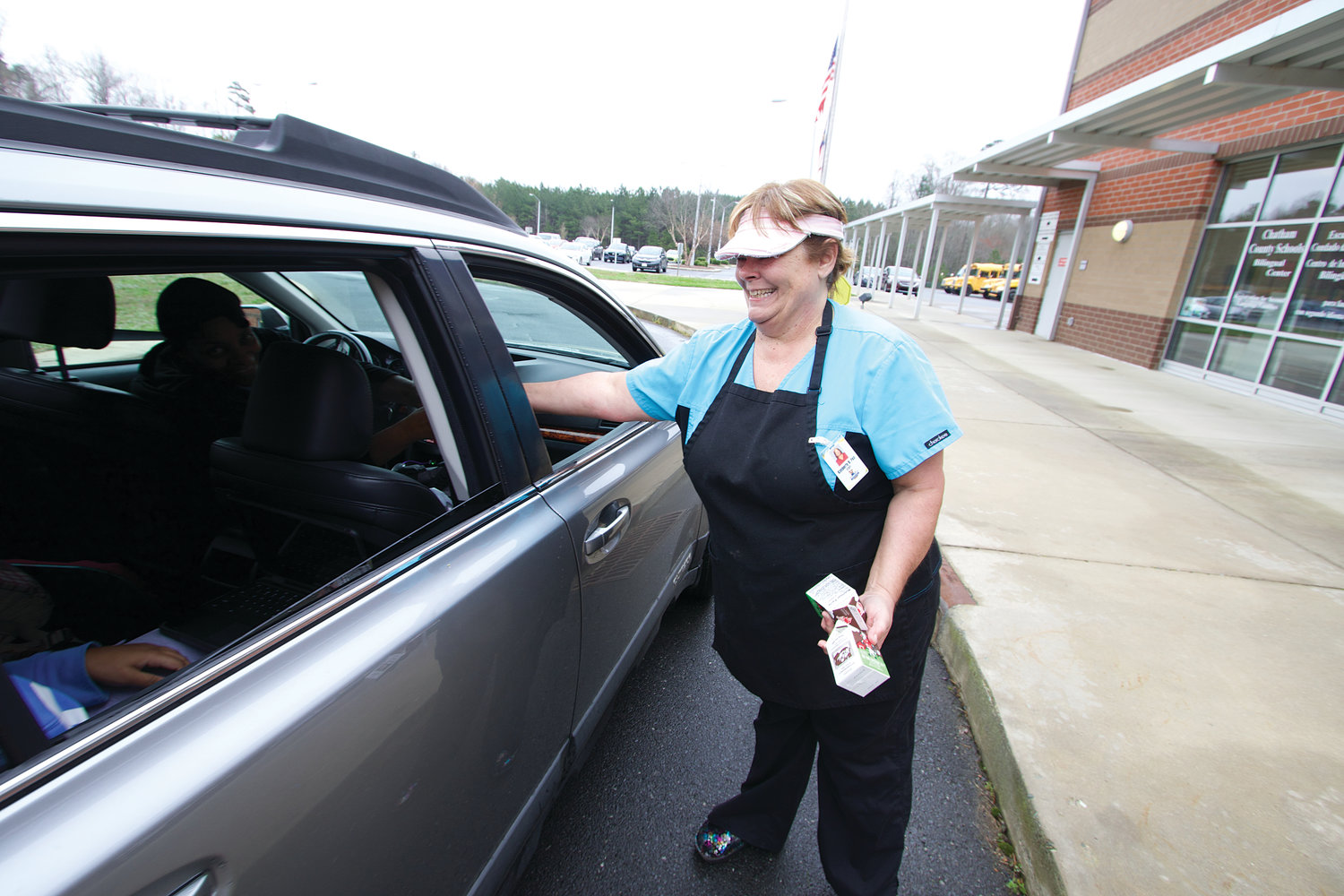![]()
By Zachary Horner, Chatham News + Record Staff
Starting on March 17, four days after Gov. Roy Cooper closed all of North Carolina’s public schools for two weeks, Chatham County Schools Nutrition Services personnel began distributing food and meals to anyone and everyone who came to designated food distribution drop-off spots around the county.
Through May 22, the district served more than 261,000 meals — nearly 4,000 meals a day if you include weekends. And it will come at a cost. While that total cost isn’t yet known, school nutrition staff will keep on serving, right through the summer.
“Food is a need, not a want,” said Jennifer Özkurt, director of school nutrition services for CCS. “When schools closed, our students were still expected to learn and continue with their schoolwork and activities. A growing child or teenager cannot learn and grow without adequate nutrition. Our goal is to nourish the child’s body and mind so the student can be at his or her best to learn.”
At the beginning of the pandemic, 46 percent of Chatham County’s public school students received free and reduced-priced meals, so there were already a number of students — around, 4,200, Özkurt said — who were in regular need of food. The district could also make money to operate the food nutrition program from what she termed “supplemental sales,” other students and faculty buying breakfast and lunch from cafeterias.
But the meal distribution set-up didn’t bring in the same revenue.
“Our district has lost revenue from our supplemental sales,” she said. “We are not feeding the same number of students and faculty we would under normal conditions.”
The situation is not unique to Chatham County Schools. In May, the School Nutrition Association, a nonprofit group that represents school nutrition personnel, reported that 68 percent of school meal program directors said they were “anticipat(ing) a financial loss” and 23 percent were “uncertain about financial losses.” Nearly 1,900 school districts nationwide were represented in the survey.
“As schools closed their doors, school nutrition professionals quickly transitioned from cafeteria service to curbside pickup, and have continued serving on the frontlines to ensure hungry students have access to healthy meals during COVID-19 closures,” SNA President Gay Anderson said in a press release accompanying the survey results. “Despite these tireless efforts, school meal programs nationwide are experiencing crippling financial losses that could impede efforts to serve students next year.”
CCS has discussed this reality during the pandemic. In an April meeting of the Chatham County Board of Education, Özkurt said the district would lose money from this effort, something Superintendent Derrick Jordan re-emphasized.
“You are in (school nutrition) to try and make money, keep it solvent,” Jordan said. “We certainly will lose money as a result of this. We are appreciative of the efforts, both at the state and national level to soften the decrease that our district, along with many others across the country, will experience.”

Kim Fox, a school nutrition assistant at Virginia Cross Elementary School, hands out chocolate milk Tuesday as part of breakfast service to families during school closures due to COVID-19.
Both federal- and state-level efforts have been made to direct funds to school nutrition programs. The N.C. General Assembly passed a bill last month to direct $75 million to the state’s Dept. of Public Instruction “for school nutrition services provided in response to COVID-19 by public school units.” And the SNA said the latest COVID-19 relief bill, the HEROES Act (which just passed the U.S. House), would direct $3 billion in federal emergency funding “to help child nutrition programs cover costs associated with COVID-19 school closures.”
How much of that funding will fall to Chatham County is not clear, but the district has said it will continue to serve meals throughout the summer, even though money is not being made.
Özkurt said that beginning June 15, meals will be offered Monday through Thursday at five schools across the county, with separate meals for Fridays offered on Thursdays as well. Additionally, bus routes for meal distribution will continue through August 7.
The important piece, Özkurt said, is getting “nutritious and healthy meals” to those who need them in Chatham County, and a recent report from the nonprofit NC Child shows that those meals are crucial, particularly for children. According to data released last week, 42 percent of Chatham County children live in families who “struggl(ed) with poverty before the pandemic struck,” and 19 percent “lived in families that struggled to put nutritious food on the table.”
NC Child said in the report that nearly 30 percent of children were in families considered “food insecure” prior to COVID-19 in Tyrell, Scotland, Washington and Robeson counties.
Özkurt said that the district may rework how child nutrition services work during the next school year, while “taking into account many factors and recommendations from the state and local government to do it in the safest way possible for our students and staff.” But in the meantime, she said, they’re focused on continuing to provide food during the pandemic. She cited working with nonprofits and other agencies in the county to make distribution possible.
“Food security is a community collaboration,” Özkurt said. “It is very important to build relationships with other outside agencies and nonprofits to reduce barriers to food access for our students anytime throughout the year.”
Chapelboro.com has partnered with the Chatham News + Record in order to bring more Chatham-focused stories to our audience.
The Chatham News + Record is Chatham County’s source for local news and journalism. The Chatham News, established in 1924, and the Chatham Record, founded in 1878, have come together to better serve the Chatham community as the Chatham News + Record. Covering news, business, sports and more, the News + Record is working to strengthen community ties through compelling coverage of life in Chatham County.










